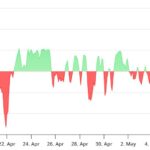Bitcoin (BTC) is making headlines again as it surged past the notable $104,000 mark on Tuesday, fueled by a combination of fresh economic data, a positive outlook from former President Donald Trump, and Coinbase’s recent inclusion in the prestigious S&P 500 index. The release of April’s Consumer Price Index (CPI), which showed lower-than-expected inflation, has sparked optimism and could ease the Federal Reserve’s concerns about rising prices.
As the market absorbed this inflation data, Fed Chair Jerome Powell’s upcoming address is anticipated to provide crucial insights into future monetary policy. Meanwhile, at the Saudi-U.S. Investment Forum, Trump expressed confidence in financial markets, stating they “could go a lot higher,” further contributing to the optimistic sentiment surrounding Bitcoin and other cryptocurrencies.
As of now, Bitcoin is trading approximately 2.4% higher in the last 24 hours, hovering around $104,400 after nearly touching $105,000. Ethereum’s ether (ETH) has also shown resilience, rising over 9% to around $2,700, while newer decentralized finance (DeFi) tokens like Eigenlayer’s EIGEN and EtherFi’s ETHFI saw impressive daily gains of over 20-30%.
In the traditional stock market, the Nasdaq and S&P 500 indices also experienced gains, closing up 1.6% and 0.75%, respectively. Coinbase’s stock notable surge of 24% stems from its integration into the S&P 500, which could unlock an estimated $16 billion in buying pressure, according to Jefferies.
Joel Kruger, a market strategist at LMAX Group, noted, “Currently, the market appears to be pausing for breath, yet the prevailing sentiment… suggests this rally still has room to grow.”
Market analysts highlight that while the cryptocurrency market enjoys this rally, institutional interest continues to rise, aided by Coinbase’s milestone in joining the S&P 500. This historic moment could potentially pave the way for increased acceptance and integration of cryptocurrency into mainstream finance.
Furthermore, Paul Howard from trading firm Wincent remarked that although altcoins are currently riding the wave of broader market enthusiasm, institutional investments may become more discerning as the landscape evolves, ideally benefitting stronger projects while weaker ones may not survive.
Looking ahead, analysts at Bitfinex predict Bitcoin could be on the brink of a new record, though the cryptocurrency is facing short-term hurdles in the $104,000 to $106,000 range. However, they believe the medium and long-term prospects remain bullish, with predictions for BTC reaching between $150,000 and $180,000 in the coming years.
“Bitcoin’s long-term outlook is the strongest it has ever been,” Bitfinex analysts stated, highlighting the increasing global adoption of cryptocurrencies and the potential of an evolving U.S. regulatory framework.

Bitcoin Hits $104,000: Key Drivers and Market Insights
Recent developments in the financial and cryptocurrency markets have created a positive momentum around Bitcoin (BTC) and altcoins. Here are some crucial points to consider:
- Bitcoin Surges Past $104,000: BTC climbed back above $104,000, driven by several favorable factors including inflation data and Trump’s market outlook.
- Low Inflation Data: April’s Consumer Price Index (CPI) came in cooler than expected, easing fears regarding Federal Reserve policies on inflation.
- Trump’s Optimism: Donald Trump is optimistic about market growth, which could increase investor confidence.
- Coinbase Joins S&P 500: Coinbase’s inclusion in the S&P 500 is significant, potentially introducing $16 billion in buying pressure for the stock.
- Altcoins Perform Well: Ethereum’s ether (ETH) increased by over 9%, while other tokens like EIGEN and ETHFI saw gains of 20-30%.
The interplay of these factors emphasizes the evolving nature of cryptocurrency markets. Here are some additional key trends:
- Institutional Interest: Increased mainstream adoption of cryptocurrency is anticipated, especially with supportive regulatory attitudes from the SEC.
- Selective Investment: Institutional capital is expected to become more discerning, favoring resilient altcoin projects over weaker ones.
- BTC’s Near-Term Outlook: Analysts predict BTC may face short-term resistance but are bullish on long-term potential, setting price targets of $150,000-$180,000 for 2025-2026.
“Bitcoin’s long-term outlook is the strongest it has ever been… evolving into a global macro reserve asset.” – Bitfinex Analysts
For readers, these insights suggest a promising possibility for cryptocurrency investments, but also highlight the need for careful consideration amid market volatility. Understanding these dynamics can help individuals and investors navigate potential opportunities and risks in the evolving financial landscape.
Bitcoin’s Resurgence and Its Impact on the Cryptocurrency Landscape
Recently, Bitcoin (BTC) has made headlines by climbing above the $104,000 mark, driven by an array of optimistic factors, including favorable inflation data and heightened Wall Street engagement. This surge is reminiscent of the bullish sentiments seen in the cryptocurrency sphere during previous bull runs, where promising economic indicators and influential endorsements sparked investor enthusiasm. Key players like President Trump and significant shifts in institutional buying, highlighted by Coinbase’s recent inclusion in the S&P 500, create a dynamic environment that could provoke both opportunities and challenges for various market participants.
One competitive advantage for Bitcoin is its renewed mainstream acceptance, which is expected to fuel additional institutional investment. Analysts predict that the inclusion of Coinbase in the S&P 500 may activate approximately $16 billion in buying pressure. This aligns with the broader trend of cryptocurrency entering the mainstream financial lexicon, potentially attracting new retail investors who had previously stayed on the sidelines. The robust performance of altcoins, such as Ethereum (ETH), further underscores a significant shift in market sentiment, which could lead to increased diversification within portfolios as traders look for high-yield assets.
However, Bitcoin’s rise is not without its pitfalls. The current resistance levels around $104,000 to $106,000 suggest a possible short-term consolidation phase, which could cause uncertainty among investors. Additionally, while enthusiasm surrounding crypto regulation is growing—thanks to SEC Chair Paul Atkins’ push for the U.S. to be a hub for crypto innovation—the lack of comprehensive clarity still looms as a potential dampener for institutional investors. This regulatory ambivalence may deter some from investing in the market right away, leading to selective capital inflows where only the strongest altcoin projects receive attention. In this context, weaker projects may struggle to sustain their market positions.
The potential for this volatile environment creates a mixed bag for different stakeholders. Institutional investors, who are increasingly turning towards Bitcoin and altcoins as credible asset classes, may find this period ripe with opportunity for strategic investments. Conversely, retail investors could face challenges navigating the volatile landscape, especially if consolidation phases lead to price retracements. Moreover, existing altcoin projects that do not adapt to evolving market dynamics may find themselves at a disadvantage, as investor interest shifts toward more resilient assets. All things considered, Bitcoin’s trajectory—fueled by both macroeconomic factors and market sentiment—will continue to shape the cryptocurrency industry’s evolution, creating winners and losers amid a backdrop of unprecedented growth and scrutiny.

















